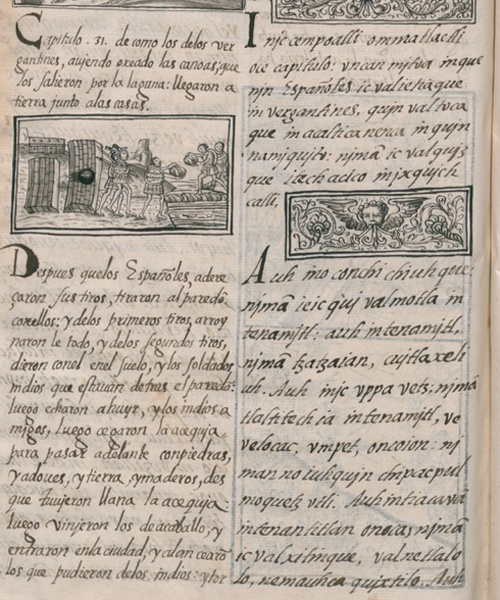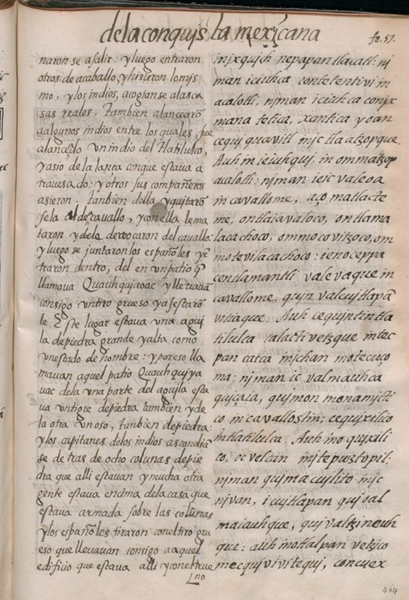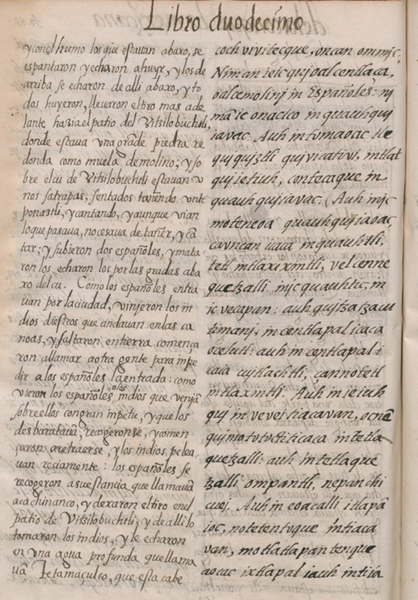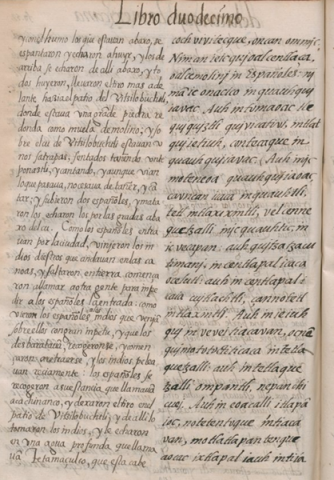 |
[Transcription of the Nahuatl (right-hand column) by James Lockhart:]
[f. 56v., cont.] Inic cempoalli ommatlactli oce capitulo: vncan mitoa in quenin Españoles ic valietiaque in vergantines, quinvaltocaque in acaltica nenca in quinnamiquito: nimā ic valquizque itech acico in ixquich calli.
Auh in oconchichiuhque: nimā ie ic quivalmotla in tenamitl: auh in tenamitl nimā tzatzaian, cuitlaxeliuh. Auh inic vppa vetz; nimā tlaltitech ia in tenamitl, vevelocac, vmpet, oncoion: niman no iuhquin chipacpul moquetz vtli. Auh in tiacavā in tenantitlan onoca, nimā ic valxitinque, valnetlalolo, nemauhcaquixtilo. Auh
|
[Translation of the Nahuatl (right-hand column) by James Lockhart:]
Thirty-first chapter, where it is said how the Spaniards came with the brigantines, pursuing those who were in boats. When they were done contending with them, they drew close and reached all the houses.
And when they had finished adjusting [the guns], they shot at the wall. The wall then ripped and broke open. The second time it was hit, the wall went to the ground; it was knocked down in places, perforated, holes were blown in it. Then, like the other time, the road stood clear. And
[Translation of the Spanish (left-hand column) by James Lockhart:]
Chapter Thirty-one, of how the brigantines, having scattered the canoes that went out against them on the lake, came to land next to the houses.
After the Spaniards had adjusted their cannon, they shot at the barrier with them. With the first volley they ruined it all, and with the second they knocked it to the ground. Then the Indian soldiers who were behind the barrier began to flee, and the friendly Indians filled in the canal with stones, adobe, earth, and timbers in order to be able to go forward.
When they had the canal filled up level, the horsemen came and entered the city, lancing the Indians that they could, then
|
[Translation of the Nahuatl into Spanish by Fr. Bernardino de Sahagún; transcription of the Spanish (left-hand column) by James Lockhart:]
[f. 56v., cont.] Capitulo .31. de como los de vergantines, auiendo oxeado las canoas; que los salieron por la laguna: llegaron a tierra junto a las casas.
[Aquí: un dibujo]
Despues que los Españoles, adereçaron sus tiros, tiraron al paredō con ellos: y de los primeros tiros, arroynaronle todo, y de los segundos tiros, dieron con el en el suelo, y los saldados indios que estauan detras el paredō: luego echaron a huyr, y los indios amigos, luego cegaron la acequia para pasar adelante con piedras, y adoues, y tierra, y maderos,
desque tuuieron llana la acequia: luego vinieron los de a caballo, y entraron en la ciudad, y alancearō los que pudieron de los indios: y tor
|
 |
[Transcription of the Nahuatl (right-hand column) by James Lockhart:]
[f. 57r.] in ixquich nepapan tlacatl: niman iciuhca contetentivi in acalotli, niman iciuhca conixmana tetica, xantica yoan cequi quavitl inic tlaatzopque.
Auh in ie iuhqui, in ommatzop acalotli: niman ie ic valeoa in cavallome, aço matlacteme, ontlaiavaloco, ontlamalacachoco, ommocovitzoco, ommotevilacachoco: ie no ceppa centlamantli valevaque in cavallome, quinvalcuitlapāvitiaque. Auh cequintin tlatilulca calactivetzque in tecpan catca in ichan motecuçoma: niman ic valmauhcaquiçaia, quimonmonamictico in cavallostin: ce quixilico in tlatilulca. Auh in oquixilico, oc vel can in itepuztopil: niman quimacuilito in icnivan, icuitlapan quioalmaiauhque, quivaltzineuhque: auh in otlalpan vetzico mec* quivivitequi, concuex
----------
*MEC. Read "nec."
|
[Translation of the Nahuatl (right-hand column) by James Lockhart:]
the warriors who had been lying at the wall dispersed and came fleeing; everyone escaped in fear. And then all the different people [who were on the side of the Spaniards] quickly went filling in the canals and making them level with stones, adobes, and some logs, with which they closed off the water.
And when the canals were stopped up, some horse [men] came, perhaps ten of them; they came going in circles, spinning, turning, twisting. Another group of horse[men] came following behind them. And some Tlatelolca who had quickly entered the palace that had been Moteucçoma's residence came back out in alarm to contend with the horse [men]. They lanced one of the Tlatelolca, but when they had lanced him, he was able to take hold of [the Spaniard's] iron lance. Then his companions took it from [the Spaniard's] hands, throwing him on his back and unhorsing him. When he fell to the ground, they struck him repeatedly
[Translation of the Spanish (left-hand column) by James Lockhart:]
they came back out, and other horsemen entered and did the same; the Indians took refuge in the royal palace. They also lanced a group of Indians, among whom was one from Tlatelolco who seized the lance with which he was pierced, and others among his companions also grabbed hold of it and took it from the horseman, and with it they killed him and unhorsed him.
Then the Spaniards assembled and entered a courtyard they called Quauhquiahuac; they took with them a heavy cannon and aimed it. [In] this place there was a large eagle of stone, as high as a man standing, and for that reason the courtyard was called Quauhquiahuac. On one side of the eagle was a tiger, also of stone, and on the other a bear [sic], also of stone. The captains of the Indians hid themselves behind eight stone columns that were there, and many other people were on top of the house that rose above the columns.
The Spaniards fired the heavy cannon that they had with them at that building that was there, and with the thunderous sound
|
[Translation of the Nahuatl into Spanish by Fr. Bernardino de Sahagún; transcription of the Spanish (left-hand column) by James Lockhart:]
[f. 57r.] naronse a salir: y luego entraron otros de a caballo, y hizieron lo mismo, y los indios, acogianse a las casas reales. Tambien alancearō a algunos indios entre los quales, fue alanceado vn indio del Tlatilulco, y asio de la lança con que estaua atrauesado: y otros sus compañeros asieron. tanbien della y quitarōsela al de a cauallo, y con ella le mataron y derrocaron del cauallo:
y luego se juntaron los españoles y ētraron dentro, del en vn patio q̄ llamaua Quauhquiaoac y lleuauā consigo vn tiro grueso y asestarōle. Este* lugar estaua vna aguila de piedra grande y alta como vn estado de hombre: y por eso llamauan aquel patio Quauhquiyauac de la vna parte del aguila estaua vn tigre de piedra: y los capitanes de los indios ascondiāse detras de ocho colunas de piedra que alli estauan y mucha otra gente estaua encima de la casa que estaua armada sobre las colūnas
y los españoles tiraron con el tiro grueso que lleuauan consigo a aquel edificio que estaua alli y con el trueno
----------
*ESTE. Normal usage would demand "en" before this word.
|
 |
[Transcription of the Nahuatl (right-hand column) by James Lockhart:]
[f. 57v.] cochvivitecque, oncan ommic.
Niman ie ic quioalcentlaça, oalcemolini in Españoles: nimā ic onacico in quauhquiiavac. Auh in tomaoac tlequiquiztli quivicativi, intlatqui ietiuh, contecaque in quauhquiiavac. (Auh inic moteneoa quauhquiiaoac, ca vncan icaca in quauhtli, tetl in tlaxixintli, vel cennequetzalli inic quauhtic, inic vecapan: auh quitzatzacutimani, in centlapal icaca ocelutl: auh in centlapal icaia cuitlachtli, çanno tetl in tlaxintli). Auh in ie iuhqui in vevei tiacavan, oc nē quimototoctiticaca in tetlaquetzalli: auh in tetlaquetzalli ompantli, nepan chicuei. Auh in coacalli itlapā ioc, no tetentoque in tiacavan, motlatlapantenque aocac ixtlapal iauh in tiia
|
[Translation of the Nahuatl (right-hand column) by James Lockhart:]
on the back of the neck, and he died there.
Then the Spaniards sent everyone, they all moved together; they reached Quauhquiahuac [Eagle Gate]. As they went they took the cannon and its gear and set it down at Quauhquiahuac. (The reason it is so called is that an eagle stood there, carved of stone, some seven feet tall, and enclosing it were a jaguar standing on one side, and a wolf standing on the other, likewise carved in stone.) And when things were in this state the great warriors tried to take shelter behind the stone pillars; there were two rows of them, eight altogether. And the roof of the Coacalli was also full of warriors. None of them ventured to cross into the
[Translation of the Spanish (left-hand column) by James Lockhart:]
and the smoke those who were below took fright and began to run away, and those above hurled themselves down, and they all fled. They took the cannon farther ahead in the direction of the square of Huitzilopochtli, where there was a large round stone like a millstone. Some satraps were seated on the cu of Huitzilopochtli, playing a teponaztli and singing, and though they saw what was happening, they did not stop playing and singing. Two Spaniards climbed up, killed them, and threw them down the steps of the cu.
As the Spaniards entered the city, the Indians skilled with canoes came and landed; they began to summon other people to prevent the Spaniards' entry.
When the Spaniards saw the Indians coming against them with great impetus and dispersing them, they regrouped and began to withdraw, and the Indians fought fiercely. The Spaniards retreated to their base, called Acachinanco, leaving the cannon in the courtyard of Huitzilopochtli. The Indians took it from there and threw it into deep water at the place they called Tetamaço!co, which is near
|
[Translation of the Nahuatl into Spanish by Fr. Bernardino de Sahagún; transcription of the Spanish (left-hand column) by James Lockhart:]
[f. 57v.] y con el humo los que estauan abaxo, se espantaron y echaron a huyr, y los de arriba se echaron de alli abaxo, y todos huyeron, llauaron el tiro mas adelante hazia el patio del Vitzilobuchtli, donde estaua vna grāde piedra redonda como muela de molino; y sobre el cu de Vitzilobuchtli estauan vnos satrapas, sentados tañendo vn teponaztli, y cantando, y aunque vian lo que pasaua, no cesaua de tañer, y cātar; y subieron dos españoles, y mataronlos echaronlos por las gradas abaxo del cu.
Como los españoles entrauan por la ciudad, vinieron los indios diestros que andauan en las canoas, y saltaron en tierra començaron a llamar a otra gente para inpedir a los espanñoles la entrada:
como vieron los españoles a los indios que veniā sobre ellos con gran inpetu, y que los desbaratauā, recogeronse, y començaron a retraerse, y los indios peleauan reciamente: los españoles se recogeron a su estancia que llamauā acachinanco, y dexaron el tiro en el patio de Vitzilobuchtli, y de alli lo tomaron los indios, y le echaron en vna agua profunda que llamauā Tetamaçulco, que esta cabe
|
 |
[Transcription of the Nahuatl (right-hand column) by James Lockhart:]
[f. 58r.] cavan.
Auh in Españoles çā niman amo mamana: auh in oquitlazque tlequiquiztli cenca tlaiovac, poctli motecac. Auh in quimotoctitimanca in tetlaquetzalli, netlaloloc yoan in ixquichtin tlapanco onoca valmotepeuhque veca netlaloloc, nec quivallecavia in tlequiquiztli contecaco temalacatitlan: auh in icpac vitzilobuchtli, oc nē tlapiaia, quivitequia in teponaztli, iuhquin ontetemi quivitequi teponaztli: auh nimā ic ontlecoque vmentin Españoles, vmpa quimonvivitequito: auh in oquimonvivitequito inca valmaiauhque, quinvalchicanauhque:
auh in quaquachictin in ixquichtin in tiacavan in acaltica tlaiecoaia, muchintin valquizque, vallalvacaquizque: auh in tetlanelhuia in telpopotzitzinti, çan iehoātin in quivalhuivicaque in
|
[Translation of the Nahuatl (right-hand column) by James Lockhart:]
open.
And the Spaniards did not move at all; when they fired the cannon, it grew very dark, and smoke spread. Those who had been taking shelter behind the stone pillars fled; all who had been lying on the roof jumped down and ran far away. Then they brought the cannon up and set it down at the round stone [of gladiatorial sacrifice]. On top of [the temple of] Huitzilopochtli they were still trying to keep watch, beating the log drums, as though the air were full of them. Then two Spaniards climbed up and struck [the drummers]; after they had struck them they cast them aside, threw them down.
And those with scraped heads, all the warriors who were fighting in boats, came onto dry land, and only the youths who poled the others conducted the
[Translation of the Spanish (left-hand column) by James Lockhart:]
the mountain called Tepetzinco, where the baths are.
|
[Translation of the Nahuatl into Spanish by Fr. Bernardino de Sahagún; transcription of the Spanish (left-hand column) by James Lockhart:]
[f. 58r.] el monte que se llama Tepetzinco, donde estan los baños.
|
 |
[Transcription of the Nahuatl (right-hand column) by James Lockhart:]
[f. 58v.] acalli. Auh in ie iuhqui in tiaiacavan, nec quimottilia in caltzalanti vellatotoca, vel netzatzililo: quitoa. Tiacavane, ma vallatotoca:
auh in ie iuhqui, in oquittaque in Españoles in ie impan monamiqui in ie quintotona,* nimā ic mocototztlalique, moteputztique, vel totoca, motlaloa necoccampa in valminaloia in tlatzontectica, yoan necoccampa in valtepacholo, quin vmpan xolloco patito, imihio quicuito, vmpa valmomanato: niman ie ic valnecuepalo. Auh in iehoantin Españoles, niman ic no mocuepa motlalito in acachinanco: auh in tlequiquiztli vncan quicauhtiquizque in temalacatitlan; niman conanque in tiacavan, quitototza quimaiavito atlan, tetamaçolco quitztiltitiaque.
----------
*QUINTOTONA. Read "quintotoca."
|
[Translation of the Nahuatl (right-hand column) by James Lockhart:]
boats. And at this point the warriors inspected the passageways, with much running and shouting, saying, "O warriors, let everyone come running!"
When things were in this condition, the Spaniards saw that they were upon them, pursuing them, and then they hunched down and retreated, running fast and fleeing. From both sides there was shooting [at the Spaniards] with barbed darts, and stones were thrown from both sides. Then they went to Xoloco to mend, catch their breath, and re-form, and then they came back. And then the Spaniards went back again and stayed in Acachinanco. In their haste they left behind the cannon on the round stone. Then the warriors took it; they quickly pushed it in the direction of Tetamacolco and threw it in the water.
[Translation of the Spanish (left-hand column) by James Lockhart:]
(intentionally blank)
|
[Translation of the Nahuatl into Spanish by Fr. Bernardino de Sahagún; transcription of the Spanish (left-hand column) by James Lockhart:]
[f. 58v., tres dibujos; sin texto en español]
|









